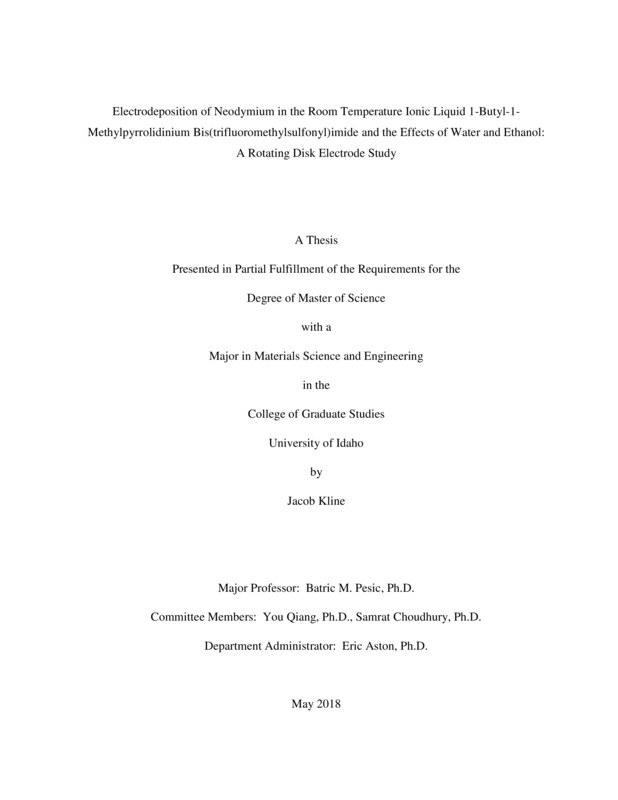Electrodeposition of Neodymium in the Room Temperature Ionic Liquid 1-Butyl-1-Methylpyrrolidinium Bis(trifluoromethylsulfonyl)imide and the Effects of Water and Ethanol: A Rotating Disk Electrode Study
Kline, Jacob. (2018-05). Electrodeposition of Neodymium in the Room Temperature Ionic Liquid 1-Butyl-1-Methylpyrrolidinium Bis(trifluoromethylsulfonyl)imide and the Effects of Water and Ethanol: A Rotating Disk Electrode Study. Theses and Dissertations Collection, University of Idaho Library Digital Collections. https://www.lib.uidaho.edu/digital/etd/items/kline_idaho_0089n_11333.html
- Title:
- Electrodeposition of Neodymium in the Room Temperature Ionic Liquid 1-Butyl-1-Methylpyrrolidinium Bis(trifluoromethylsulfonyl)imide and the Effects of Water and Ethanol: A Rotating Disk Electrode Study
- Author:
- Kline, Jacob
- Date:
- 2018-05
- Program:
- Chemical and Materials Science Engineering
- Subject Category:
- Materials Science
- Abstract:
-
Neodymium metal is widely utilized for its unique magnetic properties. Neodymium magnets are found in MRI machines, hybrid electric car motors, and in magnets that are required to operate at high temperatures. Neodymium is also found as a reaction product in spent nuclear fuels. In order to recycle these spent fuels, neodymium and other products must be removed. Due to its large electronegative deposition potential (~ -2.4 V vs SHE) traditional aqueous processes cannot be used as hydrogen evolution from water occurs prior to any metal deposition. Pyroprocessing techniques in high temperature molten salts require the arduous control of an inert atmosphere as well as the use of corrosive ions. Room temperature ionic liquids (RTIL’s) provide a unique solution to these problems as these salts are liquid at room temperature and provide a wide electrochemical window (up to 5 V) for deposition of electronegative metals.
The goal of this study was to examine the electrochemistry and deposition morphology of neodymium metal in the RTIL 1-butyl-1-methypyrrolidinium bis(trifluoromethylsufonyl)imide (BMP-TFSI). BMP-TFSI is designed to be a hydrophobic RTIL for use in open atmosphere. This particular RTIL is stable in the cathodic direction up to -3 V vs Ag/AgCl which provided adequate stability to observe the deposition of neodymium metal. The rotating disk electrode technique was used to study the electrochemistry of neodymium, water, and ethanol in BMP-TSFI. Neodymium deposition was observed at -2.4 V and the morphology was characterized using scanning electron microscopy. The effects of water and ethanol additions to BMP-TFSI were also investigated to determine their effects on the stability of the RTIL. While BMP-TFSI is designed to be hydrophobic, moisture from the atmosphere can be absorbed in small amounts. Ethanol has been proposed as a viscosity modifier, to reduce the viscosity of ionic liquids. The diffusion coefficients of water and ethanol in BMP-TFSI were calculated to be 7.6x10-7 cm2/sec and 1.8x10-9 cm2/sec respectively. The reduction of ethanol on platinum in BMP-TFSI exhibited sluggish kinetics and the rate constant was calculated to be 4.3x10-4 cm/sec. Both water and ethanol additions drastically reduced the stability window of the RTIL to approximately 2 V.
- Description:
- masters, M.S., Chemical and Materials Science Engineering -- University of Idaho - College of Graduate Studies, 2018-05
- Major Professor:
- Pesic, Batric M
- Committee:
- Qiang, You; Choudhury, Samrat
- Defense Date:
- 2018-05
- Identifier:
- Kline_idaho_0089N_11333
- Type:
- Text
- Format Original:
- Format:
- application/pdf
- Rights:
- In Copyright - Educational Use Permitted. For more information, please contact University of Idaho Library Special Collections and Archives Department at libspec@uidaho.edu.
- Standardized Rights:
- http://rightsstatements.org/vocab/InC-EDU/1.0/

